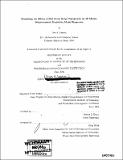| dc.contributor.advisor | Robert L. Evans. | en_US |
| dc.contributor.author | Lassner, Lisa A | en_US |
| dc.contributor.other | Woods Hole Oceanographic Institution. | en_US |
| dc.date.accessioned | 2010-10-05T14:33:28Z | |
| dc.date.available | 2010-10-05T14:33:28Z | |
| dc.date.copyright | 2004 | en_US |
| dc.date.issued | 2004 | en_US |
| dc.identifier.uri | http://hdl.handle.net/1721.1/58867 | |
| dc.description | Thesis (S.M.)--Joint Program in Oceanography/Applied Ocean Science and Engineering (Massachusetts Institute of Technology, Dept. of Earth, Atmospheric, and Planetary Sciences; and the Woods Hole Oceanographic Institution), 2004. | en_US |
| dc.description | Includes bibliographical references (leaves 68-69). | en_US |
| dc.description.abstract | Methods which measure seafloor resistivity are uniquely suited to studying hydrothermal circulation in the crust. The magnetometric resistivity (MMR) technique is a galvanic method which uses a bipole current source with a magnetometer receiver. The resistivity of the subsurface can be estimated from the magnetic field read in MMR. In order to analyze and invert MMR data taken near Mid Ocean Ridges, it is important to understand the effects of ridge topography on MMR models. To analyze these effects a 3D MMR forward modeling program MMR3Df̲wd is used to model Mid Ocean Ridges with varying slopes, resistivities, and source/receiver geometries. The modeled magnetic fields are compared with models with a flat seafloor to determine the impact of the ridge topography. Results show that for some of the ridges modeled, the effects of the topography were significant, suggesting that in some instances it is important to include ridge topography in forward models to obtain accurate results from data inversion. | en_US |
| dc.description.statementofresponsibility | by Lisa A. Lassner. | en_US |
| dc.format.extent | 69 leaves | en_US |
| dc.language.iso | eng | en_US |
| dc.publisher | Massachusetts Institute of Technology | en_US |
| dc.rights | M.I.T. theses are protected by
copyright. They may be viewed from this source for any purpose, but
reproduction or distribution in any format is prohibited without written
permission. See provided URL for inquiries about permission. | en_US |
| dc.rights.uri | http://dspace.mit.edu/handle/1721.1/7582 | en_US |
| dc.subject | Joint Program in Oceanography. | en_US |
| dc.subject | Earth, Atmospheric, and Planetary Sciences. | en_US |
| dc.subject | Woods Hole Oceanographic Institution. | en_US |
| dc.subject.lcsh | Submarine topography | en_US |
| dc.subject.lcsh | Mid-ocean ridges | en_US |
| dc.title | Examining the effects of mid ocean ridge topography on 3D marine magnetometric resistivity model responses | en_US |
| dc.type | Thesis | en_US |
| dc.description.degree | S.M. | en_US |
| dc.contributor.department | Joint Program in Oceanography | en_US |
| dc.contributor.department | Woods Hole Oceanographic Institution | en_US |
| dc.contributor.department | Massachusetts Institute of Technology. Department of Earth, Atmospheric, and Planetary Sciences | |
| dc.identifier.oclc | 56122976 | en_US |
